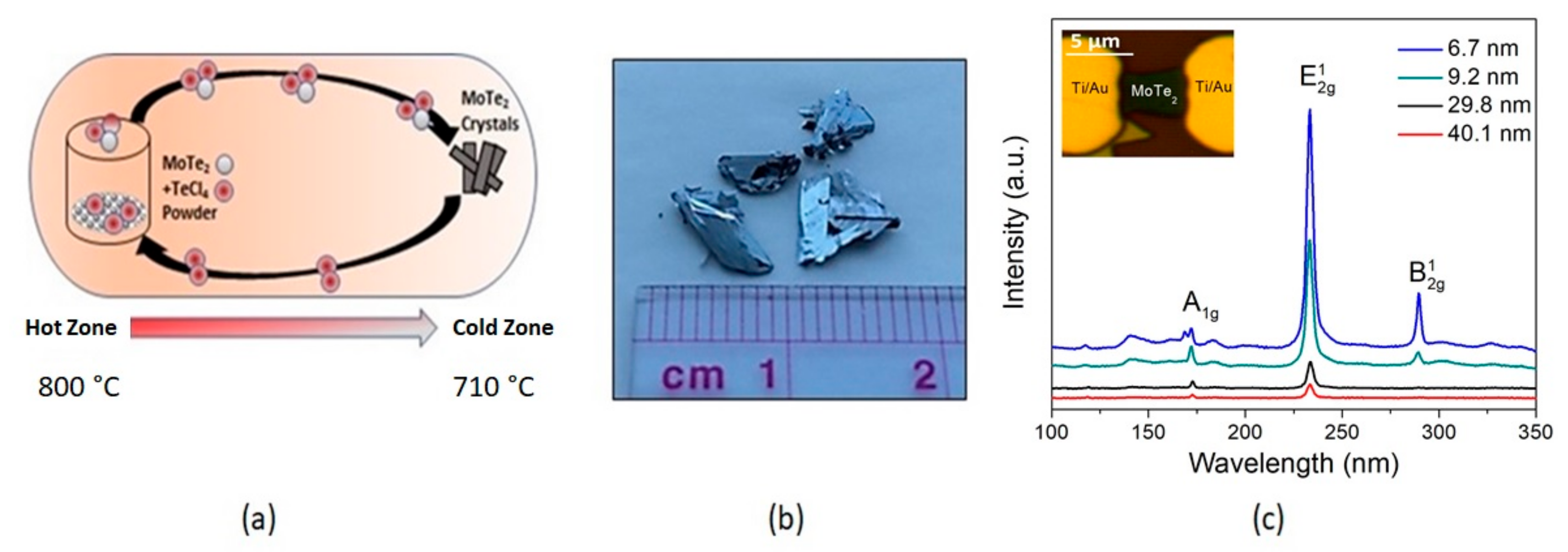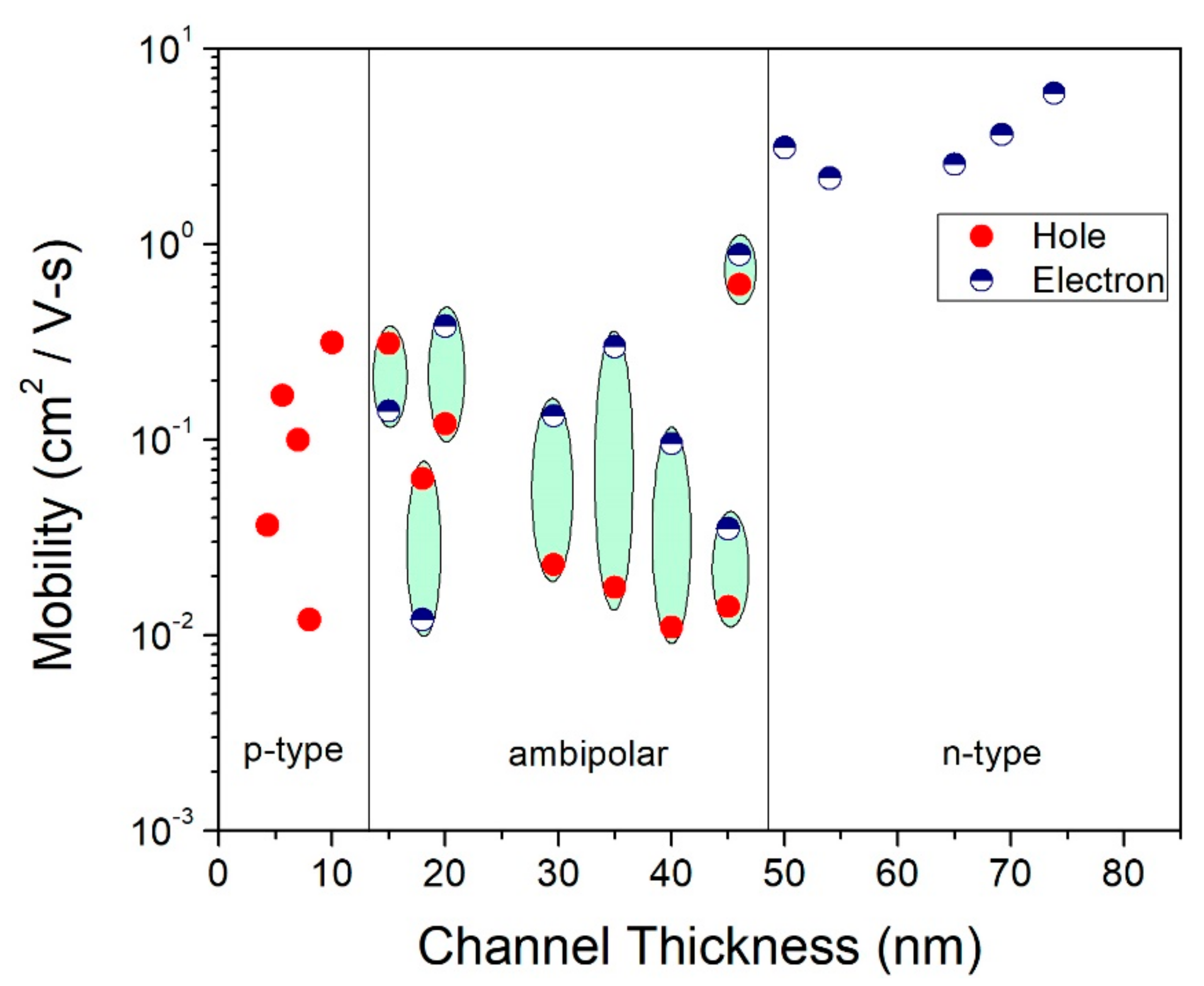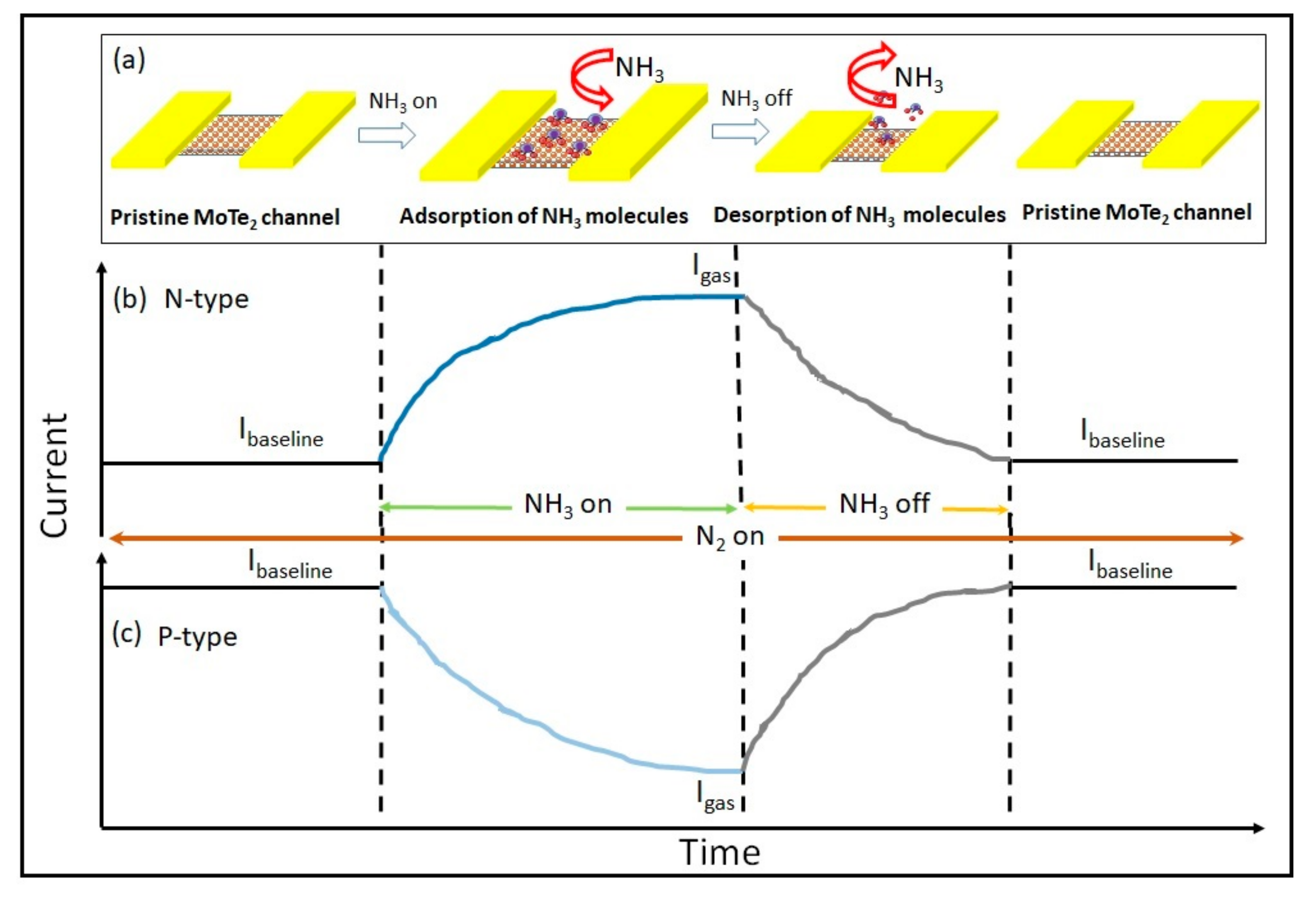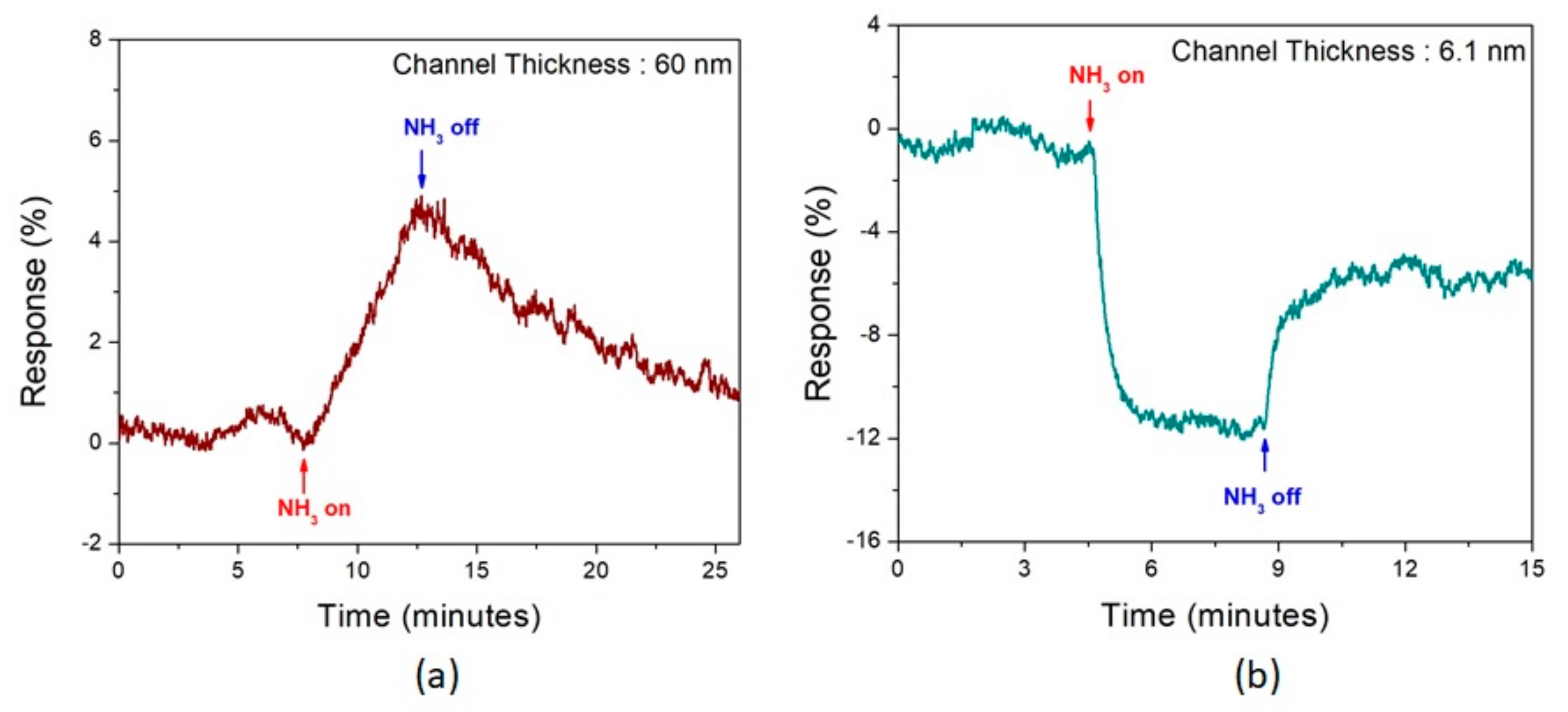Tuning the Polarity of MoTe2 FETs by Varying the Channel Thickness for Gas-Sensing Applications
Abstract
:1. Introduction
2. Materials and Methods
3. Results
4. Conclusions
Supplementary Materials
Author Contributions
Funding
Acknowledgments
Conflicts of Interest
References
- Radisavljevic, B.; Radenovic, A.; Brivio, J.; Giacometti, V.; Kis, A. Single-layer MoS2 Transistors. Nat. Nanotechnol. 2011, 6, 147–150. [Google Scholar] [CrossRef] [PubMed]
- Kim, K.S.; Zhao, Y.; Jang, H.; Lee, S.Y.; Kim, J.M.; Kim, K.S.; Ahn, J.-H.; Kim, P.; Choi, J.-Y.; Hong, B.H. Large-scale pattern growth of graphene films for stretchable transparent electrodes. Nature 2009, 457, 706–710. [Google Scholar] [CrossRef] [PubMed]
- Novoselov, K.S.; Geim, A.K.; Morozov, S.V.; Jiang, D.; Zhang, Y.; Dubonos, S.V.; Grigorieva, I.V.; Firsov, A.A. Electric field effect in atomically thin carbon films. Science 2004, 306, 666–669. [Google Scholar] [CrossRef]
- Lopez-Sanchez, O.; Lembke, D.; Kayci, M.; Radenovic, A.; Kis, A. Ultrasensitive photodetectors based on monolayer MoS2. Nat. Nanotechnol. 2013, 8, 497–501. [Google Scholar] [CrossRef]
- Yin, Z.; Li, H.; Jiang, L.; Shi, Y.; Sun, Y.; Lu, G.; Zhang, Q.; Chen, X.; Zhang, H. Single-layer MoS2 phototransistors. ACS Nano 2012, 6, 74–80. [Google Scholar] [CrossRef] [PubMed]
- Meric, L.; Han, M.Y.; Young, A.F.; Ozyilmaz, B.; Kim, P.; Shepard, K.L. Current saturation in zero-bandgap, top-gated graphene field-effect transistors. Nat. Nanotechnol. 2008, 3, 654–659. [Google Scholar] [CrossRef] [PubMed]
- Tang, Q.; Zhou, Z. Graphene-analogous low-dimensional materials. Prog. Mater. Sci. 2013, 58, 1244–1315. [Google Scholar] [CrossRef]
- Fiori, G.; Bonaccorso, F.; Iannaccone, G.; Palacios, T.; Neumaier, D.; Seabaugh, A.; Banerjee, S.K.; Colombo, L. Electronics based on two-dimensional materials. Nat. Nanotechnol. 2014, 9, 768–779. [Google Scholar] [CrossRef]
- Strait, J.H.; Nene, P.; Rana, F. High Intrinsic Mobility and Ultrafast Carrier Dynamics in Multilayer Metal-Dichalcogenide MoS2. Phys. Rev. B 2014, 90, 245402. [Google Scholar] [CrossRef]
- Bao, W.Z.; Cai, X.H.; Kim, D.; Sridhara, K.; Fuhrer, M.S. High Intrinsic Mobility and Ultrafast Carrier Ambipolar MoS2 Field-Effect Transistors: Substrate and Dielectric Effects. Appl. Phys. Lett. 2013, 102, 042104. [Google Scholar] [CrossRef]
- Pradhan, N.R.; Rhodes, D.; Feng, S.M.; Xin, Y.; Memaran, S.; Moon, B.-H.; Terrones, H.; Terrones, M.; Balica, L. Field- Effect Transistors Based on Few- Layered alpha-MoTe2. ACS Nano 2014, 8, 5911–5920. [Google Scholar] [CrossRef] [PubMed]
- Ding, Y.; Wang, Y.; Ni, J.; Shi, L.; Shi, S.; Tang, W. First principles study of structural, vibrational and electronic properties of graphene-like MX2 (M = Mo, Nb, W, Ta; X = S, Se, Te) monolayers. Phys. B 2011, 406, 2254–2260. [Google Scholar] [CrossRef]
- Ataca, C.; Sahin, H.; Ciraci, S. Stable, Single-Layer MX2 Transition-Metal Oxides and Dichalcogenides in a Honeycomb-Like Structure. J. Phys. Chem. C 2012, 116, 8983–8999. [Google Scholar] [CrossRef]
- Ma, Y.; Dai, Y.; Guo, M.; Niu, C.; Lu, J.; Huang, B. Electronic and magnetic properties of perfect, vacancy-doped, and nonmetal adsorbed MoSe2, MoTe2 and WS2 monolayers. Phys. Chem. Chem. Phys. 2011, 13, 15546–15553. [Google Scholar] [CrossRef] [PubMed]
- Kuiri, M.; Chakraborty, B.; Paul, A.; Das, S.; Sood, A.K.; Das, A. Enhancing photoresponsivity using MoTe2-graphene vertical heterostructures. Appl. Phys. Lett. 2016, 108, 063506. [Google Scholar] [CrossRef]
- Li, H.-M.; Lee, D.-Y.; Choi, M.S.; Qu, D.; Liu, X.; Ra, C.-H.; Yoo, W.J. Metal-Semiconductor Barrier Modulation for High Photoresponse in Transition Metal Dichalcogenide Field Effect Transistors. Sci. Rep. 2014, 4, 4041. [Google Scholar] [CrossRef]
- Nakaharai, S.; Yamamoto, M.; Ueno, K.; Tsukagoshi, K. Carrier Polarity Control in α-MoTe2 Schottky Junctions Based on Weak Fermi-Level Pinning. ACS Appl. Mater. Interfaces 2016, 8, 14732–14739. [Google Scholar] [CrossRef]
- Resta, G.V.; Sutar, S.; Balaji, Y.; Lin, D.; Raghavn, P.; Radu, I.; Catthoor, F.; Thean, A.; Gaillardon, P.-E.; Micheli, G. Polarity control in WSe2 double-gate transistors. Sci. Rep. 2016, 6, 29448. [Google Scholar] [CrossRef]
- Feng, Z.; Xie, Y.; Wu, E.; Yu, Y.; Zheng, S.; Zhang, R.; Chen, X.; Sun, C.; Zhang, H.; Liu, J.; et al. Enhanced Sensitivity of MoTe2 Chemical Sensor through Light Illumination. Micromachines 2017, 8, 155. [Google Scholar] [CrossRef]
- Ping, J.; Fan, Z.; Sindoro, M.; Ying, Y.; Zhang, H. Recent advances in sensing applications of two-dimensional transition metal dichalcogenide nanosheets and their composits. Adv. Funct. Mater. 2017, 27, 1605817. [Google Scholar] [CrossRef]
- Yang, S.; Jiang, C.; Wei, S.-H. Gas sensing in 2D materials. Appl. Phys. Rev. 2017, 4, 021304. [Google Scholar] [CrossRef]
- Choi, S.J.; Kim, I.D. Recent developments in 2D Nanomaterials for Chemiresistive-Type Gas Sensors. Electron. Mater. Lett. 2018, 1–40. [Google Scholar] [CrossRef]
- Liu, X.; Ma, T.; Pinna, N.; Zhang, J. Two-dimensional layered nanostructured materials for gas-sensing. Adv. Funct. Mater. 2017, 27, 2168. [Google Scholar] [CrossRef]
- Cho, B.; Hahm, M.G.; Choi, M.; Yoon, J.; Kim, A.R.; Lee, Y.-L.; Park, S.-G.; Kwon, J.-D.; Kim, C.S.; Song, M.; et al. Charge-transfer based gas sensing using atomic-layer MoS2. Sci. Rep. 2015, 5, 8052. [Google Scholar] [CrossRef] [PubMed]
- Liu, B.; Chen, L.; Liu, G.; Abbas, A.N.; Fathi, M.; Zhou, C. High-performance chemical sensing using Schottky-contacted chemical. ACS Nano 2014, 8, 5304–5314. [Google Scholar] [CrossRef] [PubMed]
- Late, D.J.; Huang, Y.-K.; Liu, B.; Acharya, J.; Shirodkar, S.N.; Luo, J.; Yan, A.; Charles, D.; Waghmare, U.V.; Dravid, V.P.; et al. Sensing behavior of atomically thin-layered MoS2 transistors. ACS Nano 2013, 7, 4879–4891. [Google Scholar] [CrossRef] [PubMed]
- Lezama, I.G.; Ubaldini, A.; Longobardi, M.; Giannini, E.; Renner, C.; Kuzmenko, A.B.; Morpurgo, A.F. Indirect-to-direct band-gap crossover in few-layer MoTe2. Nano Lett. 2015, 15, 2336–2342. [Google Scholar] [CrossRef] [PubMed]
- Singh-Miller, N.E.; Marzari, N.N. Surface energies, work functions, and surface relaxations of low index metallic surfaces from first principles. Phys. Rev. B. Condens. Matter 2009, 80. [Google Scholar] [CrossRef]
- Oliver, S.M.; Beams, R.; Krylyuk, S.; Kalish, I.; Singh, A.K.; Bruma, A.; Tavazza, F.; Joshi, J.; Stone, I.R.; Stranick, S.J.; et al. The structural phases and vibrational properties of Mo1−xWxTe2 alloys. 2D Mater. 2017, 4, 045008. [Google Scholar] [CrossRef]
- Huang, Y.; Sutter, E.; Shi, N.N.; Zheng, J.; Yang, T.; Englund, D.; Gao, H.-J.; Sutter, P. Reliable exfoliation of large-area high-quality flakes of graphene and other two–dimensional materials. ACS Nano 2015, 9, 10612–10620. [Google Scholar] [CrossRef]
- Benameur, M.M.; Radisavljevic, B.; Heron, J.S.; Sahoo, S.; Berger, H.; Kis, A. Visibility of dichalcogenide nanolayers. Nanotechnology 2011, 22, 125706. [Google Scholar] [CrossRef] [PubMed]
- Golasa, K.; Grzeszczyk, M.; Molas, M.R.; Zinkiewicz, M.; Bala, L.; Nogajewski, K.; Potemski, M.; Wysmolek, A.; Babinski, A. Resonant quenching of Raman scattering due to out-of-plane A1g/A’1 modes in few-layer MoTe2. Nanophotonics 2017, 6, 1281–1288. [Google Scholar] [CrossRef]
- Shimada, T.; Shuchi, S.F.; Parkinson, A.B. Work function of photothreshold of layered metal dichalcogenides. Jpn. J. Appl. Phys. 1994, 33 Pt 1, 2696–2698. [Google Scholar] [CrossRef]
- Rani, A.; DiCamillo, K.; Krylyuk, S.; Debnath, R.; Taheri, P.; Pranajape, M.; Korman, C.E.; Zaghloul, M.E.; Davydov, A.V. Control of Polarity in Multilayer MoTe2 Field-Effect Transistors by Channel Thickness. In Proceedings of the Low-Dimensional Materials and Devices 2018, San Diego, CA, USA, 11 September 2018; Volume 10725. [Google Scholar] [CrossRef]
- Hyunjin, J.; Gwanmu, L.; Min-Kyu, J.; Yoojoo, Y.; Hojoon, Y.; Ji-Hoon, P.; Dongseok, S.; Chu, S.L. Thickness-dependent carrier mobility of ambipolar MoTe2: Interplay between interface trap and Coulomb scattering. Appl. Phys. Lett. 2017, 110, 183501. [Google Scholar] [CrossRef]
- Perello, J.D.; Chae, H.S.; Song, S.; Lee, H.Y. High-performance n-type black phosphorous transistors with type control via thickness and contact- metal engineering. Nat. Commun. 2015, 6, 7809. [Google Scholar] [CrossRef]
- Kwon, J.; Lee, Y.J.; Yu, J.Y.; Lee, H.C.; Cui, X.; Hone, J.; Lee, H.G. Thickness-dependent Schottky barrier height of MoS2 field-effect transistors. Nanoscale 2017, 9, 6151–6157. [Google Scholar] [CrossRef]
- Cai, Y.; Zhang, G.; Zhang, W.Y. Layer-dependent band alignment and work function of few-layer phosphorene. Sci. Rep. 2014, 4, 6677. [Google Scholar] [CrossRef]
- Legma, J.B.; Vacquier, G.; Casalot, A. Chemical vapour transport of molybdenum and tungsten diselenides by various transport agents. J. Cryst. Growth 1993, 130, 253–258. [Google Scholar] [CrossRef]
- Yang, L.; Majumdar, K.; Liu, H.; Du, Y.; Wu, H.; Hatzistergos, M.; Hung, P.; Tieckelmann, R.; Tsai, W.; Hobbs, C.; et al. Chloride Molecular Doping Technique on 2D Materials: WS2 and MoS2. Nano Lett. 2014, 14, 6275–6280. [Google Scholar] [CrossRef]
- Townsend, N.J.; Amit, I.; Cracium, M.F.; Russo, S. Sum 20 meV Schottky barriers in metal/MoTe2 Junctions. 2D Mater. 2018, 5, 025023. [Google Scholar] [CrossRef]
- Attena, J.J.; Uijttewaal, M.A.; Wijs, G.A.; Groot, R.A. Work Function Anisotropy and surface stability of half-metallic CrO2. Phys. Rev. B 2008, 77, 165109. [Google Scholar] [CrossRef]
- Liu, Y.; Stradins, P.; Huai, S.H. Van der Waals metal-semiconductor junction: Weak Fermi level pinning enables effective tuning of Schottky barrier. Sci. Adv. 2016, 2, e1600069. [Google Scholar] [CrossRef]
- Kim, C.; Moon, I.; Lee, D.; Choi, M.S.; Ahmed, F.; Nam, S.; Cho, Y.; Shin, H.-J.; Park, S.; Yoo, W.J. Fermi level pinning at electrical metal contacts of monolayer molybdenum dichalcogenides. ACS Nano 2017, 11, 1588–1596. [Google Scholar] [CrossRef]
- Li, S.-L.; Wakabayashi, K.; Xu, Y.; Nakaharai, S.; Komatsu, K.; Li, W.-W.; Lin, Y.-F.; Aparecido-Ferreira, A.; Tsukagoshi, K. Thickness-dependent interfacial Coulomb scattering in atomically thin field-effect transistors. Nano Lett. 2013, 13, 3546–3552. [Google Scholar] [CrossRef]







© 2019 by the authors. Licensee MDPI, Basel, Switzerland. This article is an open access article distributed under the terms and conditions of the Creative Commons Attribution (CC BY) license (http://creativecommons.org/licenses/by/4.0/).
Share and Cite
Rani, A.; DiCamillo, K.; Khan, M.A.H.; Paranjape, M.; Zaghloul, M.E. Tuning the Polarity of MoTe2 FETs by Varying the Channel Thickness for Gas-Sensing Applications. Sensors 2019, 19, 2551. https://doi.org/10.3390/s19112551
Rani A, DiCamillo K, Khan MAH, Paranjape M, Zaghloul ME. Tuning the Polarity of MoTe2 FETs by Varying the Channel Thickness for Gas-Sensing Applications. Sensors. 2019; 19(11):2551. https://doi.org/10.3390/s19112551
Chicago/Turabian StyleRani, Asha, Kyle DiCamillo, Md Ashfaque Hossain Khan, Makarand Paranjape, and Mona E. Zaghloul. 2019. "Tuning the Polarity of MoTe2 FETs by Varying the Channel Thickness for Gas-Sensing Applications" Sensors 19, no. 11: 2551. https://doi.org/10.3390/s19112551
APA StyleRani, A., DiCamillo, K., Khan, M. A. H., Paranjape, M., & Zaghloul, M. E. (2019). Tuning the Polarity of MoTe2 FETs by Varying the Channel Thickness for Gas-Sensing Applications. Sensors, 19(11), 2551. https://doi.org/10.3390/s19112551




